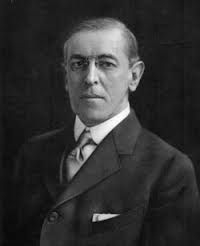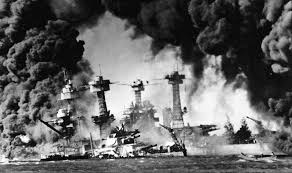DECEMBER 13 — 2003 Saddam Hussein captured in Operation Red Dawn; 1913 Federal Reserve created through Glass-Owens Act; 1941 White House Christmas Tree lighted
DECEMBER 13
2003– Hussein captured in Operation Red Dawn.
Born to a poor family in 1937 in Tikrit, a town 100 miles outside of Baghdad in Iraq, Saddam Hussein joined the radical Ba’ath party as a teenager. He replaced his cousin as president of Iraq in1979 and d brought with him schools, hospitals, and electricity. He also brought torture and terror through his newly formed Republican Guard security force.
Supposedly he was so obsessed with security, Hussein never slept in a known location. During the 1980s Iraq and Iran broke out in an eight year war where perhaps over a million people on both sides perished. Hussein was known for using poison gas on a Kurdish population of northern Iraq, killing 5,000. But when he turned his attention to taking over Kuwait; an area he felt justifiably belongs to Iraq, the United Nations got involved and sent Hussein packing without the objection of capturing him.
I’ve had parties that lasted longer than Operation Desert Storm. Chances are you’ve been to one of them.
Anyway, that wouldn’t be until later after toying with United States president George Bush by taunting him with regard to the possession of weapons of mass destruction, and turning away U.N. inspectors. President Bush convinced the public that Hussein was hiding his WMDsand legend has it that he gutted airplanes to place the WMDs and sent transported them somewhere else, but there’s no evidence of that that I could find. Either way, he had no WMDs after an extensive military search of the country, but Hussein was on the run. But his luck finally ran out on thief say in 2003 in the town of ad-Dawn, right next to his old stomping grounds of Tikrit.
It wouldn’t take long for the 1st Brigade Combat Team of the 4th Infantry Division, commanded by Major General Raymond Odierno and Colonel James Hickey of the 4, and Task Force 121, to find Saddam Hussein in a tiny foxhole in the ground. He didn’t look good. Normally we all saw pictures of his handsome smiling face dressed in his garb, or a military uniform, or even casual wear. Now his hair was matted and his beard had grown thick, and he did not resist arrest. The Middle East had various reactions to the capture of Hussein, with Egypt, Afghanistan Kuwait and Iran applauding the U.S., while the Many other countries were waiting to see how Hussein’s replacement would turn out before passing judgement, and others, such as the Palestinian Authority, announced that the U.S. would pay dearly for the capture of Hussein.
During his trial he refused to take it seriously, but was found guilty, and executed December 30, 2006.
1862 – Battle of Fredericksburg. Maj. Gen. Ambrose Burnside of the Union Army of the Potomac V Gen. Robert E. Lee’s Army of Northern Virginia. The result: Confederate Victory.
…After the Union victory in Antietam in September, President Abraham Lincoln was ready to sign the Emancipation Proclamation January 1, 1863. He needed another Union victory to give it momentum. General George McLellan however, dragged his feet and was slow on the move, so Lincoln replaced him with the reluctant Burnside, one of the most aggressive Generals of the Potomac Army. Burnside’s plan was to seize Fredericksburg and cross the Rappahannock River before the Rebels could block him on the way to Richmond. They reached Falmouth nearby, and General Lee entrenched his army on the heights behind the town on November 14. But Burnside’s bridges had not yet arrived, fouling his plan. Ah, bureaucracy! By the time the bridge pontoons showed up on November 19, snowfall delayed the war for a week, giving Lee plenty of time to send Lt. General James Longstreet and Lt. gen.
Stonewall Jackson to reinforce the area of Fredericksburg across the river. Finally on December 11th, the bridges were complete. But the Union was under heavy fire from General William Barksdale’s Mississippians. On the 12th, the Yankees crossed the river and took over the city. But on this day, December 13, just west and north of the city at Marie’s Heights and Prospect Hill, they were no match for the Rebel’s fortifications, and the casualties were staggering. The Northerners lost around 13,000 men compared to the Southerner’s 4,000. It was a disaster or the Union Army. Union Major General George Meade’s division was able to penetrate Stonewall Jackson’s line, but not for long and was driven back. Epic fail, dude. Burnside finally called off the attack and retreated across the river. President Lincoln would sign the Emancipation Proclamation notwithstanding, but the Union morale was at new lows.

1918 – President Wilson makes first US presidential trip to Europe.
…He was trying to bring peace to Europe, although some would argue that. WWI raged for years in Europe and America’s involvement only lasted only during the final six months. Some debate the consequences of America’s involvement, saying that if America had stayed out of Europe’s war, Germany probably would’ve taken France and Belgium, but not likely England since the royal navy had somewhat of a stranglehold on Germany’s abilities to get supplies, mainly food. Unlike America, England seemed to understand that the Great War would definitely not be the war to end all wars. Besides, it’s often argued, if America had stayed out, there would not be a Bolshevik coup in Russia and the country would continue to deteriorate.
Although these theories are entertaining, generally it’s believed it wouldn’t have gone down like that. The French would be speaking German, and alliances between Japan, Italy and Germany would’ve formed regardless. When Wilson promoted his League of Nations, the losers of WWI weren’t invited, and that my friends, along with France’s longing for revenge since Germany humiliated the French in 1870, the rise of socialism and the Nazis, are some of the main contributing factors of WWII. But arguing Wilson started WWII way back in 1918 might be the same as arguing whether time is immutable or not and corrects its path regardless of changes on the way.
1913—The Federal Reserve is created through the Glass-Owens Act.
All because of the Panic of 1907. Perhaps by now you’ve heard me drone on about Republican leader Nelson Aldrich and German American Paul Warburg actually created it, or how Aldrich was behind the Jekyll Island secret meeting between the big bankers, and other horror stories about the creation of the Federal Reserve. The question of the difference between a European economic style bill that would favor a central bank devised by Aldrich, and the similar one devised by Democrat newspaper publisher Carter Glass and Oklahoma Democratic Senator Robert Owen’s?
According to Wikipedia, Aldrich’s plan, smaller private banks had more of a controlled interest, whereas the Glass Owens bill would focus more on the public entity, or the Federal Reserve Board, and give more self-governing freedom to Regional reserve banks, and let them continue to set their own discount rate, as well as mandatory nationally chartered bank membership, not optional. Debates went on in Congress, as President Woodrow Wilson’s best advisor who never had an actual office position Col. Edward House was a closet socialist whose alter ego and book character Philip Drub, criticized capitalism in his book Philip Dru: Administration, was a huge fan of the Glass Owen bill and let President Professor Wilson know. Minnesota republican congressman Charles Lind burgh, the father of aviator Lucky Lindbergh, was the one of the biggest opposes of the Glass-Owen Bill, and therefore was not allowed to speak on the floor during the debates. Aldrich would admit in a speech in front of Columbia University just two months prior that it’s time to “abandon the doctrine that states have still any virile powers under our form of government, and to assent to the concentration of all powers and authority in the national government, to be exercised through Congress, or in later days, through agents of the executive.” Aldrich would admit also, that the Federal Reserve changed America from a democracy to an autocracy, by definition.
The Phrasemaker signed the act on this day in 1913, an act which his own Secretary of Treasury: “Bankers fought the Federal Reserve legislation with the tireless energy of man fighting a forest fire. They said it was populistic, socialistic, half-baked, destructive, infantile, badly conceived, and unworkable.” That was Wilson’s Secretary of Treasurer saying this. Yet others will call the Federal Reserve the prime force behind two world wars, plus many others during the 20th century.
And yet, the Phrasemaker’s presidential campaign was, He kept us out of war.

1941 – Washington decides to light the Christmas Tree. Remember that up until the 7th of December, American’s were often divided which side to take, if any, in WWII. Of course the bombing of Pearl Harbor by the Japanese united America to not just fight, but crush the Axis powers. Not lighting the tree on the South Lawn of the White House would demoralize America, so the lighting continued, presided by Eleanor Roosevelt, and in fact was followed by a patriotic theme. Carols sung included Joy to the World, Adeste Fideles, It Came Upon the Midnight Clear and Silent Night.

